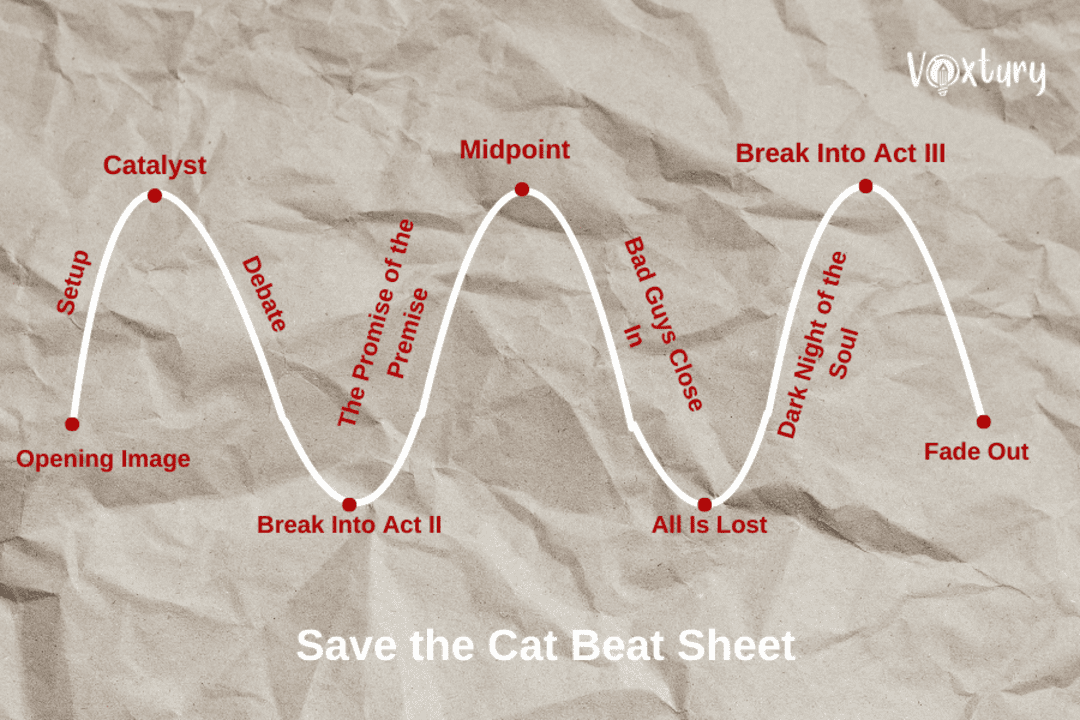Writing a book is not an easy feat – that’s no secret. However, there are several tools and resources that you can use to make this process easier and Save the cat! beat sheet is one of those. Although we know that the name might not be the most telling about what it’s about, it actually comes from a screenwriting book by Blake Snyder.
So, what does the title mean? Well, in the book, Snyder mentions how if you have a hero who is very hard to like, to say the least, you need to make him do something good in the early part of the story to make the audience be on his side. They have to, so to say, “save the cat” or do another heroic act.
Still confusing? Probably so, but don’t worry – you’ll understand it better once we show you some examples or dive deeper into what it actually does for you as an author.
Key Highlights
- The Save the Cat Beat Sheet was invented by Blake Snyder and was originally intended to be used in screenwriting, but throughout the years, it has also become a useful tool for writers.
- The template consists of 15 sections, also known as beats, that can be divided into three acts.
- There are a number of reasons why the Save the Cat Beat Sheet works, including its easy-to-follow structure, keeping the audience entertained, and focus on character transformation.
- The framework can be useful for both novice writers who are just starting their journey and seasoned ones who might be starting a new project, experiencing writer’s block or switching to a new genre.
What Is the Save the Cat Beat Sheet?
Save the Cat! Beat Sheet is a template that was originally created for screenwriting, but has found use in book writing as well. It consists of 15 steps (beats) that give you a full novel outline. Each beat has a specific number of pages it would take – we highlighted those as a bracketed number next to each section, using a standard 110-page screenplay as the base.

Here are the beats divided into three acts:
ACT I
Opening Image [1]
This is the opening snapshot of your main character or the world that will change as a result of future events. It’s also an insight for your audience regarding what kind of story they’re about to experience. This is before the adventure begins.
Theme Stated [5]
This is when the audience is introduced to the main theme of your story and the hero’s arc. It’s typically a sentence uttered either by the main character or by another character to your hero.
There are many story arc themes to choose from, including Rags to Riches (a story with a happy ending), Riches to Rags (a story with a bad ending), Main in a Hole (the main character is faced with an impossible situation and triumphs) and Cinderella (a story with a rise, fall and rise again that ends with a happy ending).
Set Up [1-10]
In this beat, the audience learns more about the character’s life before the future events that are about to change it, including their work and family – they’re also introduced to secondary characters. This is also when we’re shown the main character’s reluctance to change, and we learn about what could happen if they don’t.
Catalyst [12]
This is when the main story is set in motion by an inciting incident—it needs to be life-changing enough to prevent the main character from going back to their old life. This is also called a “call to adventure.” Common examples include death, a breakup, or losing their job.
Debate [12-25]
The protagonist is debating how to proceed after the events from the Catalyst beat. Usually spawning across multiple scenes (or chapters in the case of a book), it shows the main character’s hesitance to take action.
ACT II
Break Into Two [25]
The main character decides to accept the call to action and makes a no-turning-back decision – it could be leaving their comfort zone, trying something new, or taking on a new way of thinking.
This takes them into a new world – the separation between the world in Act 1 (before taking action) and Act 2 (the world after the main character takes action).
B Story [30]
This is when the subplot starts, introducing a new character (or multiple characters) that will help the main character learn the life lesson. Common themes of the substory include friendship, mentorship, or love.
Fun and Games [30-55]
Also called the “promise of the premise,” this section is where most scenes in the trailer happen—that’s also where the name comes from, as that’s where the “hook” of the movie or novel takes place. The hero is put in a new world and explores it, either loving or hating it.
Midpoint [55]
This is the middle of the movie or novel—the events from the Fun and Games beat culminate, either in a false victory or a false defeat. It’s also where the stakes are raised, pushing the hero forward.
Bad Guys Close In [55-75]
This is when the hero either gets a new goal or modifies the previous one. The progress of this beat depends on what happened in the midpoint – if the midpoint was a false victory, this is typically where things take a turn for the worse. If, on the other hand, the midpoint was a false defeat, this is the moment where things start looking up for your hero. The bad guys mentioned here can be external or internal.
All Is Lost [75]
This beat is when the main character is pushed to rock bottom. Featuring a “whiff of death,” either metaphorically or literally, it symbolizes the transformation from the old hero who dies to the rebirth of a new hero.
Dark Night of the Soul [75-85]
During this beat, the main character processes what has happened thus far and what they have lost – it shows how the protagonist changed under the influence of past events.
ACT III
Break Into Three [85]
This is when the main character experiences some sort of realization or comes across new information that allows them to devise a plan to solve their problem. Despite the emotional despair, the discovery and the journey they have experienced up to this point will keep the hero moving forward.
Finale [85-110]
The main character overcomes the problematic situation or is defeated by it. In positive story arcs, the bad guys are destroyed, and the protagonist’s world changes for the better. In negative story arcs, on the other hand, the bad guys win, and the main character meets their fate.
Final Image [110]
Mirror image to beat 1 – it’s a snapshot showing how the main character and their world have transformed after the situation they’ve been through.
Why Does the Save the Cat Beat Sheet Work

There are several reasons why this template works:
- It’s an easy-to-follow structure – The breakdown into 15 separate but chronological beats ensures that they are easy to implement in the story.
- It’s universal – As mentioned, it was originally intended for screenplays, but nowadays, writers also use it for their works.
- It keeps the audience engaged – Through the use of multiple turning points it keeps the viewers and readers interested in how the story unfolds.
- It focuses on character transformation – At its core, Save the Cat beat sheet is all about character development. The protagonist learns an important life lesson.
- It’s flexible – The framework can be adapted to the needs of your specific story.
Tips for Using the Save the Cat Beat Sheet
Are you considering using this framework for your future work? Here are some tips that might turn out to be helpful when doing so:
- Make sure you understand all 15 beats. Before you start any writing, you need to make sure that you perfectly understand what’s the purpose of each of the beats and their role in the story.
- Focus on the major beats first. Don’t jump into deep waters by trying to write a detailed outline in one go. Instead, take your time and start with the more important first – that would be the Opening Image, Catalyst, Midpoint, and Finale. Once you have those, you can fill in the smaller beats, and then you can focus on making it more detailed.
- Don’t forget about the emotions. While Save the Cat Beat Sheet ensures a well-paced plot, you can’t forget about the emotional core of your story. Try to build an emotional connection between the main character and your audience.
- Ensure A story aligns with the B story. Remember that the B story is a subplot, meaning it’s supposed to enrich the protagonist’s journey and tie into the overall theme.
When to Use the Save the Cat Beat Sheet
The Save the Cat Beat Sheet is helpful in several scenarios, but one we just have to mention is for new writers – when you decide to write your first novel or screenplay, you might become overwhelmed by its length. With this framework, you can break the plot into several smaller parts, making the whole task appear more achievable.
Seasoned writers will also be able to take advantage of it, whether they’re starting a new project, have writer’s block and cannot move forward with the plot, or are trying out writing a new genre.
The Bottom Line
Despite its original purpose being helping screenwriters, the Save the Cat Beat Sheet has become a common tool used by novelists when crafting a plot driven by character development. Consisting of 15 separate beats, it gives you a clear breakdown of your plot and shows you any imperfections it might have, making room for improvement.
There are several resources that can help you when writing, whether we’re talking about a screenplay or a novel – and the Save the Cat Beat Sheet is just one of those. Voxtury’s online editor is another – with it, you can improve your writing by removing repetitions and typos, among other things.
Want to learn more about the theoretical aspects of the writing industry? We’ve got you covered. Our book writing, book publishing, and book promoting sections tell you all there is to know – and they’re constantly being updated, too. So, browse through our selection and find the information you need for when you’re ready to pull the trigger on publishing your work.